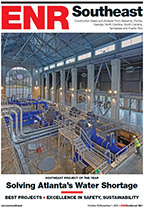Across the U.S., experts are seeing a rising influx of work in the water, wastewater and stormwater markets, as many projects that were previously postponed due to a lack of funding are now moving forward.
“We see a lot of pent up demand in the industry, with needs continuing to increase,” says David Kinchen, associate vice president of Black & Veatch’s water design-build business. “We are optimistic that the market will continue to grow and will be sustainable over time.”
|
|
In several regions across the country, significant water and wastewater programs are underway to upgrade wastewater treatment plants, improve infrastructure, boost stormwater management capacity and build more resiliency against drought. Large-scale projects, specifically in Miami-Dade County, California’s Santa Clara Valley and across the state of Texas, are creating lots of immediate opportunities and will continue to supply work over the next several years, Kinchen says.
This work includes the $100-million phase-one construction of the Donald M. Somers Water Pollution Control Plant rehabilitation for the city of Sunnyvale, Calif. Phase-one construction will focus on building new primary treatment facilities by 2020. Phases two and three are expected to be finished by 2030 at a cost of $350 million, and all five phases are slated for completion by 2042.
More favorable market conditions are driving owners to turn increasingly to alternative delivery contract models to get projects designed and built quicker, according to Matt Scott, senior vice president of Kiewit Infrastructure West Co. “Alternative delivery offers more cost and schedule certainty and enables owners, designers and contractors to work together more collaboratively,” he says. “We view this as a positive trend for the industry.”
In the drought-prone West and Southwest—particularly in California—water stress continues to be a huge driver for water-supply projects. “In response to California’s drought, we’re seeing several projects in the Los Angeles Basin that involve stormwater capture for recharging groundwater basins,” Scott says.
As an example, the Los Angeles Dept.of Water and Power recently started construction on a $29-million groundwater recharge facility expansion that will provide for 5 billion gallons of stormwater that can be captured and stored via a 150-acre tract of porous soil in the San Fernando Valley.
Scott also sees lots of emerging opportunities in the Los Angeles region for groundwater purification projects, where entities are building advanced, smaller-scale plants for locally treating groundwater to either distribute to clients or reinject back into the ground for later use.
As a by-product of the drought, Scott says water conservation measures have created a significant decrease in sewage outfalls. “We are now seeing some projects that change the way wastewater is treated to accommodate this shift,” he notes.
The need to build more climate-resilient infrastructure is driving projects in urban communities that are vulnerable to flooding and higher-intensity storms, says Elizabeth Heider, chief sustainability officer at Skanska.
“In Washington, D.C., for example, local government has recognized the limitations of their aging infrastructure and have put in place measures to accommodate stormwater, especially during epic storms, so there isn’t an overtake of the system,” Heider says.




Post a comment to this article
Report Abusive Comment